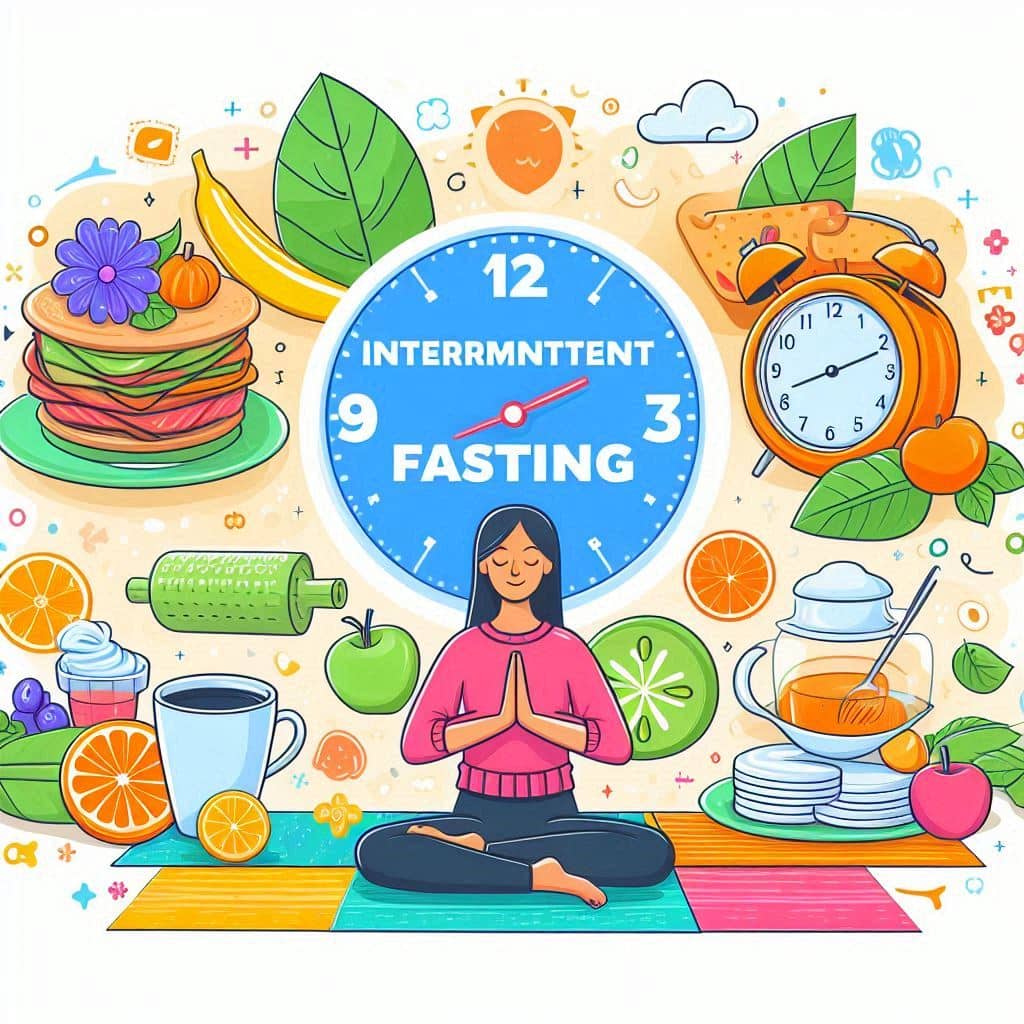Beginner’s Guide To Intermittent Fasting
Hi, I’m Mike. Are you considering intermittent fasting? I’m glad I found it when I did. My journey began when a routine blood test revealed alarming results: My cholesterol was 450, I had the onset of liver disease, and I was pre-diabetic. Determined to improve my health, I discovered intermittent fasting (IF) and found substantial research backing its benefits for the mind and body.
Motivated by these studies, I immersed myself in learning everything I could about IF. The results have been remarkable—during my first month, I lost 36 lbs and experienced significant improvements in my overall health.
I’m excited to share what I’ve learned about intermittent fasting. Here, you will find a small beginner’s guide to intermittent fasting, offering insights and practical tips to help you on this transformative journey towards better health and well-being. Let’s dive in and explore the principles, benefits, and various intermittent fasting methods, empowering you to make informed choices.
You may have heard about intermittent fasting before. If not, let me explain. Intermittent fasting (IF) is a dietary approach that’s gained significant traction for its potential health benefits. Unlike typical diets, it involves alternating cycles of fasting and eating.
Intermittent fasting isn’t a one-size-fits-all solution. A few methods exist, each with its schedule and rules. Despite its rising profile, intermittent fasting is often clouded by myths. Some believe it’s synonymous with starvation or extreme dieting, but this isn’t the case.

Understanding the Benefits of Intermittent Fasting
Now, I will explain why so many people have adopted intermittent fasting and what it could do for you. The benefits of this eating pattern go beyond simple weight loss. Studies have shown intermittent fasting (IF) can lead to weight loss and improved metabolic health.
For one, intermittent fasting is linked to better weight management. Limiting your eating to a specific window may reduce your caloric intake without requiring strict calorie counting. This can lead to weight loss and reduce the likelihood of obesity. Furthermore, it can improve your metabolism, helping your body to burn fat more efficiently.
Beyond weight, evidence suggests that intermittent fasting can improve metabolic health. It’s been associated with lower risks of type 2 diabetes by helping to reduce insulin resistance. This means your body can control blood sugar levels better, which is a win for long-term health.
Mental clarity and increased energy are also frequently cited as perks of intermittent fasting. This is thought to occur as your body adjusts to burning fat for fuel, providing a more constant energy source than the ups and downs of energy derived from carbs.
Studies support these claims, with individuals reporting physical transformations and improvements in concentration and overall well-being. It’s not just about looking good—it’s about feeling good, too. While many benefits are backed by research, intermittent fasting (IF) is not a one-size-fits-all solution, and what works for one person may not work for another.
Are you ready to try intermittent fasting? But where do you begin?
The following section will guide you through STARTING STRONG: setting yourself up for success with intermittent fasting, including choosing the right plan and preparing your mindset for future changes.
How to Get Started With Intermittent Fasting: A Step-by-Step Guide
You might want to start intermittent fasting but need help determining where to begin. I get it; the options can be overwhelming. Here’s a straightforward, step-by-step guide to get you going.
- Assess Your Routine: Choose a fasting plan that aligns with your lifestyle. The 16/8 method is a popular starting point. If you prefer less frequent but longer fasts, 24-hour fasts 1-2 times a week might suit you better.
- Ease Into It: Gradually reduce your eating window. Start by shortening it by an hour for a few days until you reach your target.
- Stay Hydrated and Nourished: Manage hunger and stay hydrated. Include fiber and protein-rich foods in your eating window to stay fuller longer.
- Balanced Diet: Focus on a balanced diet with veggies, lean proteins, and whole grains. Avoid filling your eating window with high-calorie, nutrient-poor foods.
- Monitor and Adjust: Take notes on how you feel and what works. Intermittent fasting isn’t one-size-fits-all, and personal adjustment is vital.
Be prepared for challenges. Hunger pangs, social events, and the occasional lack of energy are all part of the process. Have strategies ready, such as scheduling social meals within your eating window and planning what you’ll eat.
Take notes on how you feel, what’s working, and what isn’t. This is a learning experience, and it’s essential to tweak your approach as needed. Remember, intermittent fasting isn’t a one-size-fits-all solution, and personal adjustment is critical.
Summary
As with any change to your diet and lifestyle, starting intermittent fasting demands careful consideration and, often, a conversation with a healthcare provider. Call your healthcare provider if you have underlying health issues or are taking medication; it’s essential to get professional advice to ensure that fasting is a safe and healthy choice for you.
Once you begin your intermittent fasting journey, keep a close eye on how you feel. Energy levels, mood fluctuations, and physical responses like hunger indicate how your body adjusts. Take note of any drastic changes, and don’t hesitate to contact a doctor if something doesn’t feel right.
Finally, remember that fasting is just one piece of the health puzzle. A balanced diet during eating periods, regular physical activity, and proper rest are equally important. Integrating questions into a holistic approach to health can lead to the best outcomes. Listen to your body, be patient with the process, and focus on sustainable lifestyle changes contributing to your overall well-being.
Frequently Asked Questions (FAQs) About Intermittent Fasting.
As you embark on your journey into intermittent fasting, you might encounter some common questions. Here are answers to three frequently asked questions to help you navigate this approach to intermittent fasting with confidence:
1. What foods won’t break a fast?
Foods that won’t break a fast are typically low in calories and don’t spike insulin levels significantly. Some examples include plain water, black coffee, and plain tea. Non-caloric sweeteners, herbal teas, and supplements like electrolytes or vitamins are considered safe during fasting. However, it’s essential to check labels and consult a healthcare professional to ensure your fasting goals are compatible.
2. Why am I not losing any weight on 16:8 fasting?
While the 16:8 fasting method can be effective for weight loss for many individuals, several factors might contribute to a lack of progress. Firstly, calorie intake during the eating window should still be controlled, as consuming excess calories can hinder weight loss. Stress, sleep quality, and hormonal imbalances can also impact weight loss efforts. It’s essential to assess overall dietary habits, stress levels, and other lifestyle factors to identify potential barriers and make necessary adjustments.
3. What happens after 1 month of intermittent fasting?
Many people experience physical and mental changes after one month of intermittent fasting. Some may notice weight loss, improved energy levels, better mental clarity, and enhanced metabolic health markers such as improved insulin sensitivity. Others may experience changes in appetite regulation and food cravings. However, individual experiences vary widely based on starting weight, diet quality, activity level, and overall health status. Consistency, patience, and listening to your body are vital to experiencing the full benefits of intermittent fasting over time.
Engage with Me!
Ask Questions: Please comment below if you have any questions about intermittent fasting (IF). And remember to share this on social media!








Great read, Michael! Your guide on intermittent fasting is both comprehensive and accessible for beginners. I especially appreciate how you debunk common myths and emphasize the importance of personalizing the approach to suit individual lifestyles. The step-by-step guide and focus on mental clarity and energy benefits are particularly helpful. I’m curious, what’s your take on intermittent fasting for people with irregular work schedules or those who do shift work? Do you have any tips for them to successfully integrate fasting into their routines? Looking forward to your insights!
Hi Hanna,
Thank you for your kind words about my recent guide on intermittent fasting. I’m thrilled that you found it comprehensive and accessible, and I’m glad the step-by-step approach resonated with you.
You raised an excellent question about intermittent fasting for people with irregular work schedules. Although it’s a common concern, intermittent fasting can still be successfully integrated into such routines with some adjustments.
Here are some tips to consider:
1. Stay Flexible: Adjust your fasting windows to fit your hours and lifestyle.
2. Listen to Your Body: Listen to hunger signals and energy levels.
3. Plan Meals: Preparing meals and snacks in advance can help you stay on track.
4. Keeping Hydrated: Stay hydrated throughout the day, especially during fasting times.
5. Be Forgiving: Don’t stress over occasional breaks from your fasting schedule.
6. Prioritize Sleep: Consistent sleep patterns can support your fasting efforts and overall well-being.
7. Seek Professionals: If you have health concerns, talk with a doctor before changing your diet.
These tips help you navigate intermittent fasting more efficiently, even with your unique schedule.
Remember, it’s all about finding what works best for you and your body.
I wish you all the best on your intermittent fasting journey!
Best regards,
Michael
Hello. I’ve been doing intermediate fasting now for several months.I find that it’s harder to do at home. Because there’s food everywhere. When I’m at work it’s easier because I can just go to my car at lunch break. Also I drink coffee throughout the day. That helps keep my appetite down. I think 6 hours is the minimum time. For intermediate fasting.
Hello, Jack,
It’s great to hear that you’ve been practicing intermittent fasting for several months! Sticking to it at home surrounded by food can be challenging. Having a routine and setting boundaries for yourself can be helpful. Maybe try designating specific areas in your home for eating and keeping other spaces food-free.
Interestingly, you find it easier at work. Having a distraction-free environment during lunch breaks sounds like a good strategy. Coffee is popular, but make sure it is black without creamer or sugar. This will help you manage your fasting window.
Intermittent fasting schedules come in various lengths. While some people do well with a shorter eating window of 6 hours, many standard fasting plans involve an 8-hour eating window followed by a 16-hour fasting window (written as 16:8).
The most important thing is to find a plan that fits your lifestyle and your body’s needs.
Keep up the excellent work, and stay consistent!
Feel free to reach out if you ever need more tips or support.
All the best,
Michael
Hey Mike,
Thanks for sharing this insightful guide on intermittent fasting! You’ve done an excellent job breaking down the concept and providing practical steps for beginners. Your step-by-step guide is incredibly user-friendly. Easing into intermittent fasting by gradually shortening the eating window is a smart approach that makes the transition smoother. Emphasizing hydration and a balanced diet during eating windows is also crucial advice. It’s all about sustainable lifestyle changes rather than quick fixes that you’ve captured that well.
Overall, your guide is thorough and engaging, offering a balanced view of intermittent fasting.
Do you have any tips for staying flexible with intermittent fasting in such scenarios without feeling restricted or missing out on social experiences?
Hello, Kavita,
Thank you for the kind words!
I’m glad you found the guide on intermittent fasting helpful and user-friendly. It’s great to hear that the approach and emphasis on hydration and balanced nutrition resonated with you.
Regarding staying flexible with intermittent fasting, especially during social events, here are a few tips that might help:
Plan Ahead: If you know you have social events coming up, try to adjust your eating window accordingly. You can shift your fasting hours earlier or later to accommodate special occasions.
Be Flexible with the Rules: Intermittent fasting is a sustainable lifestyle change, not a rigid regimen. It’s okay to occasionally adjust your fasting schedule to enjoy social events without guilt.
Choose Wisely: During social gatherings, make mindful food choices. Opt for healthier options and control portion sizes, even if you eat outside your usual window.
Stay Hydrated: Drinking water or non-caloric beverages can help you feel full and avoid overeating when you break your fast.
Focus on the Social Aspect: Social events are about connecting with others. Focus on conversations and activities rather than just the food.
Communicate Your Goals: Tell your friends and family about your intermittent fasting goals. They can offer support and help you find suitable food options.
Listen to Your Body: If you feel overly restricted or stressed, taking a break from fasting is okay. The key is to maintain a healthy and balanced approach overall.
These tips help you navigate social situations while following your intermittent fasting routine. Feel free to reach out if you have any more questions!
All the best,
Michael
I sincerely appreciate this article so very much! After 4 kids and a busy life, I have found myself with prediabetes. I have been eating a more mediterranean diet, with no real change. Intermittent fasting was mentioned but not explained. Here’s to hoping this will help me! Thank you Mike for the article! I look forward to reading more!
Hello, Ashley,
I’m glad you found the article helpful!
Intermittent fasting can be a beneficial addition to your routine, and you might consider several different methods. For instance, the 16/8 method involves fasting for 16 hours and eating during an 8-hour window each day. Other variations include the 18/6 method, which involves fasting for 18 hours and eating during a 6-hour window. Then, you have the 5:2 method, where you eat normally for five days and restrict calories on two non-consecutive days.
It’s always a good idea to consult with a healthcare provider before starting any new diet, especially for people with prediabetes. They can provide personalized advice and ensure that intermittent fasting is safe and effective.
My doctor didn’t care; he was excited for me to get started. I had prediabetes, too, before I got started with the 16/8. I also had a cholesterol of 450 and the start of liver disease. I can say that intermittent fasting has saved my life.
Thanks for sharing, and I hope you start seeing positive health changes, too!
Follow me. I post new content on intermittent fasting every week. I would love to hear more about your progress! Email or chat with me anytime.
All the Best,
Michael
I first heard about intermittent fasting when a friend told me that she was doing it to maintain her weight. So it is amazing to see that you lost 36 pounds during the first month of intermittent fasting.
You mention that one might fast for 24 hours for one or two days per week. But does that means one literally eat nothing for a full day? Or is there a small allowance of say 200 calories that is allowed?
Is the 16:8 that you mention 16 hours of eating with 8 hours of fasting? Or is it the other way around that you fast for 16 hours? Thank you for clarifying.
I’m glad to share my experience!
Intermittent fasting can indeed be quite effective for weight management.
To answer your questions:
Fasting for 24 hours: Yes, fasting for 24 hours usually means consuming no calories during that period. Some people might allow themselves a minimal amount of calories, like 200, typically from non-caloric beverages or small snacks, but this can vary based on individual preference and tolerance.
The 16:8 method involves fasting for 16 hours and eating during an 8-hour window each day. You would refrain from consuming any calories for 16 hours (which often includes overnight sleep) and then have your meals within the remaining 8 hours. For example, you might eat between noon and 8 PM and then fast from 8 PM until noon the next day. That is what I do, and it is easy.
I hope this helps clarify things! Let me know if you have any more questions.
All the best!
Michael
Hello! I’m trying to start an intermittent fasting method. Actually, I am doing it without knowing because I have no choice! These days, I wake up at 10-11 am. So I eat around 12 up to 8 pm. And honestly, I am not that hungry anymore. I eat proteins, fruits, vegetables, and healthy fats. The next thing will be for me to drink lots of water and fruit juices when I don’t eat.
Hello, Angelce,
That sounds like you’re naturally falling into an intermittent fasting routine! It’s great that you’ve found a schedule that works for you, eating between 12 pm and 8 pm. Incorporating proteins, fruits, vegetables, and healthy fats provides balanced nutrition during your eating window.
Staying hydrated with plenty of water and fruit juices during fasting periods is an intelligent choice to support your overall well-being. Keep listening to your body and adjusting as needed.
If you have any questions or need further guidance on intermittent fasting, please ask!
All the best,
Michael
Hi Michael,
Your guide is an excellent introduction to intermittent fasting. And I’m very interested in learning about the most common obstacles people encounter when they first start intermittent fasting and how they can overcome them.
Additionally, how crucial is it to select the appropriate fasting schedule, and what factors should individuals consider when making this decision?
Lastly, what advice are you for maintaining adequate nutrition and energy levels while adhering to an intermittent fasting routine?
Your insights into these queries would benefit individuals new to intermittent fasting. I’m eagerly anticipating your thoughts.
Hi Sara,
Thank you for your kind words about my guide on intermittent fasting! I’m glad to hear that you found it helpful. Here are some insights into the questions you’ve raised:
Common Obstacles in Intermittent Fasting and Overcoming Them
1. Hunger and Cravings:
Solution: Gradually ease into fasting by starting with shorter fasting periods and slowly increasing the duration. Staying hydrated, drinking water, herbal teas, or black coffee can help manage hunger. Including high-fiber and protein-rich foods in your eating window can keep you fuller for longer.
2. Social and Lifestyle Challenges:
Solution: Plan your fasting schedule around your lifestyle. Communicate your fasting plan with friends and family to gain their support. Meal prep and carry healthy snacks to avoid breaking your fast with unhealthy options.
3. Fatigue and Low Energy:
Solution: Ensure you’re consuming nutrient-dense foods during your eating window. Avoid overly restrictive diets and listen to your body—rest when needed and engage in light activities to boost energy without overexertion.
Selecting the Appropriate Fasting Schedule.
Choosing the proper fasting schedule is crucial for sustainability and effectiveness. Factors to consider include:
Lifestyle: Consider your daily routine, work schedule, and social commitments. Align your fasting period with times when you are less likely to be tempted by food.
Personal Preferences: Some people prefer eating in the morning, while others find it easier to skip breakfast. Choose a schedule that fits your natural eating patterns.
Health Goals: Different fasting schedules may better suit specific health goals, such as weight loss, improved metabolic health, or cognitive function.
Medical Conditions: If you have any medical conditions, consult with a healthcare professional to determine a safe and effective fasting regimen.
Maintaining Nutrition and Energy Levels.
To maintain adequate nutrition and energy levels.
Balanced Meals: Focus on well-balanced meals that include a variety of nutrients—proteins, healthy fats, complex carbohydrates, vitamins, and minerals.
Hydration: Drink plenty of water throughout the day. Hydration is critical to managing hunger and maintaining energy levels.
Quality over Quantity: Opt for whole, unprocessed foods over calorie-dense but nutrient-poor options. Add fruits, vegetables, lean proteins, and healthy fats to your diet.
Listen to Your Body: How your body responds to different foods and fasting periods. Adjust your diet and fasting schedule to ensure you feel your best.
I hope these insights help you on your intermittent fasting journey. Feel free to reach out with any more questions you may have!
Best regards,
Michael